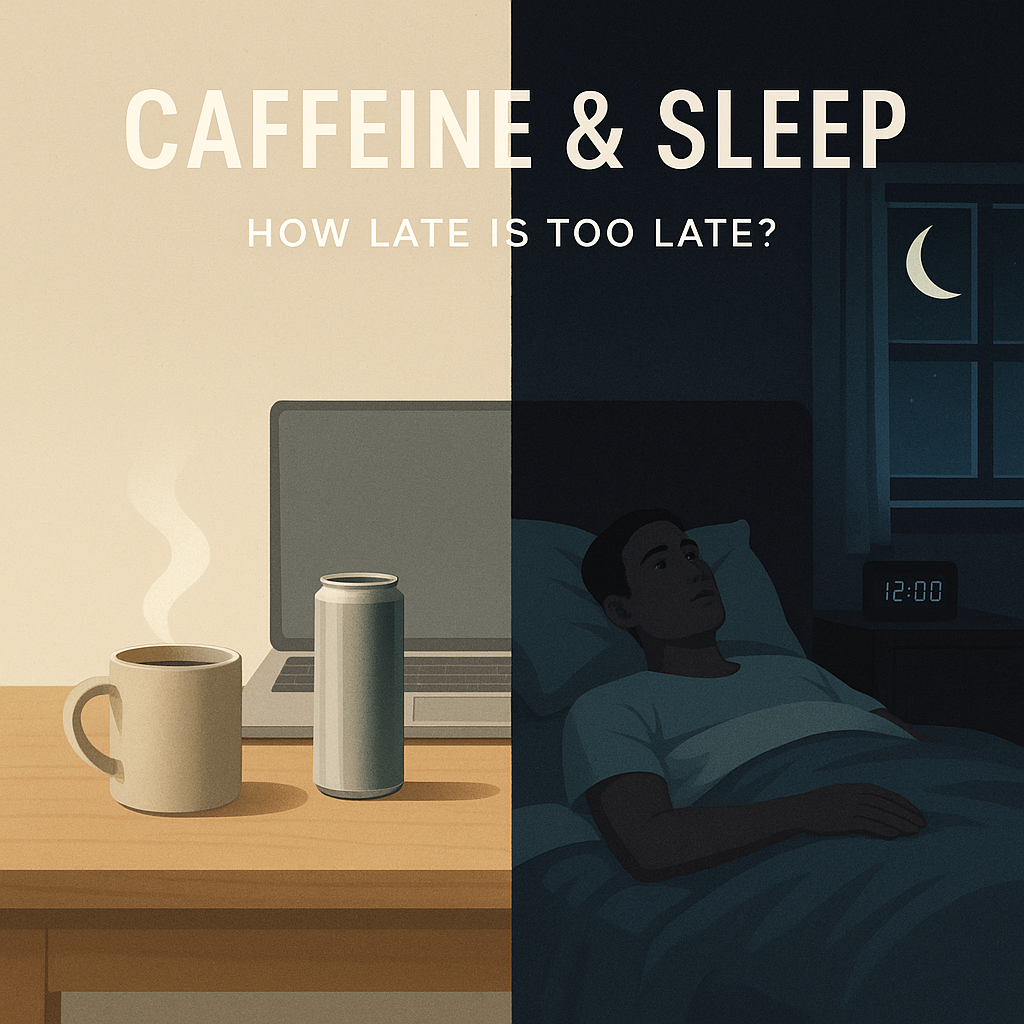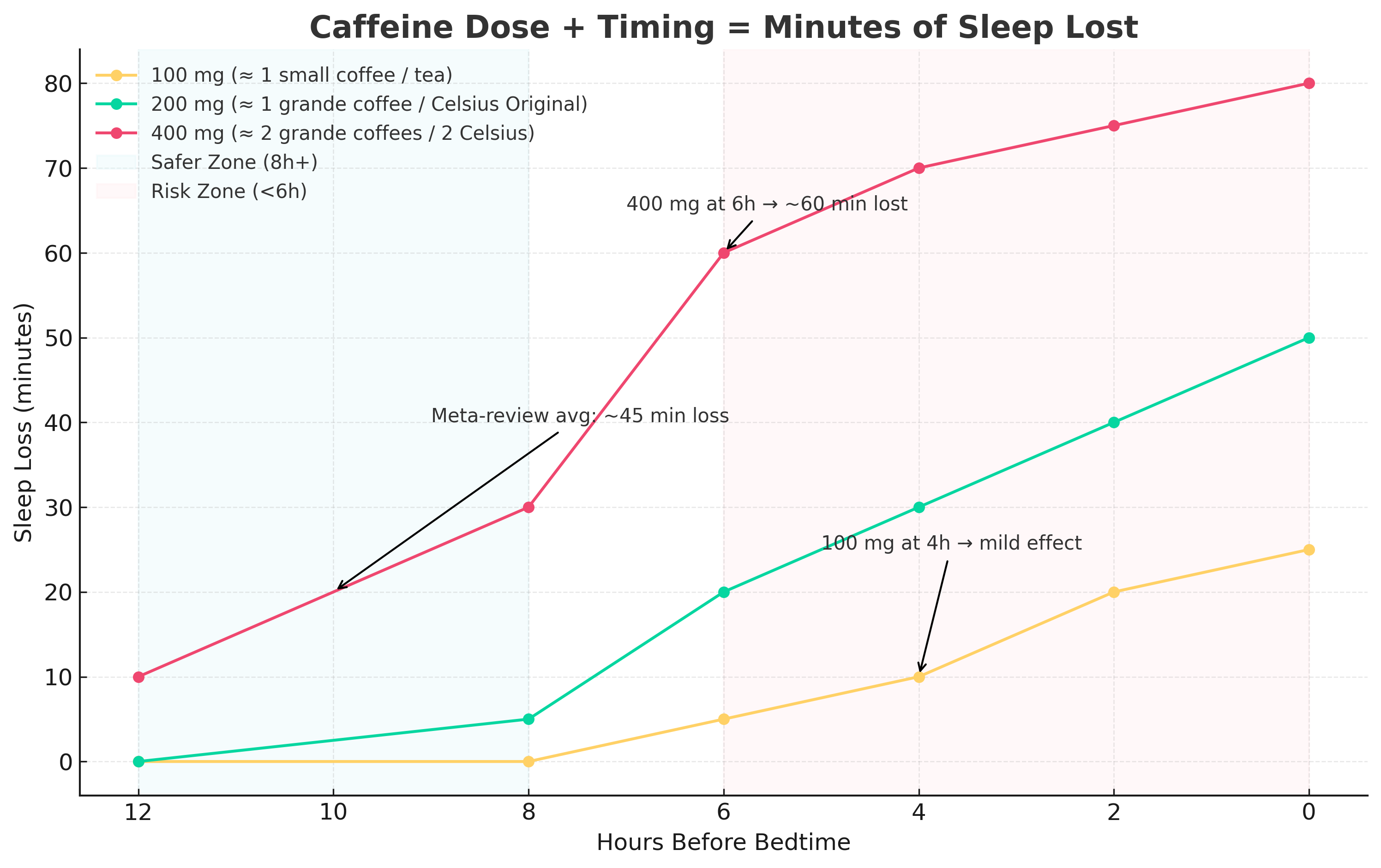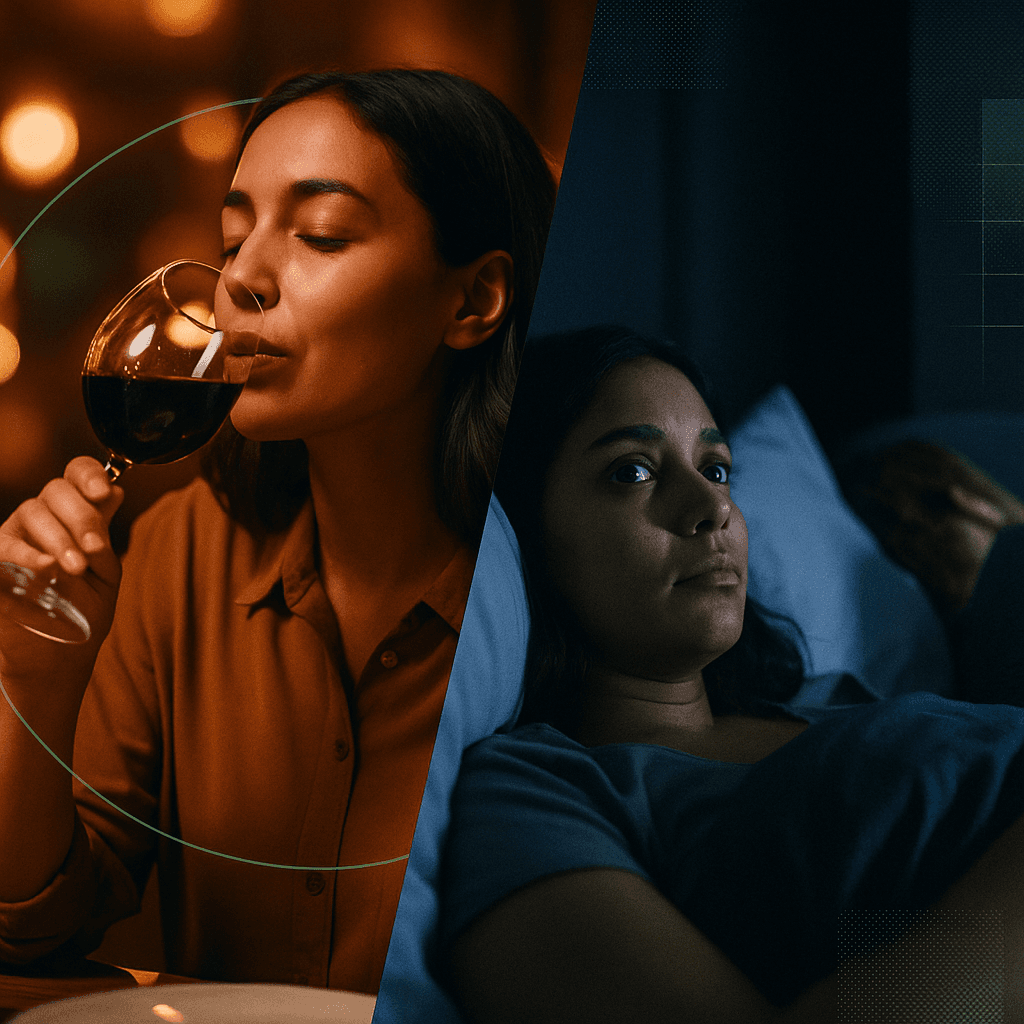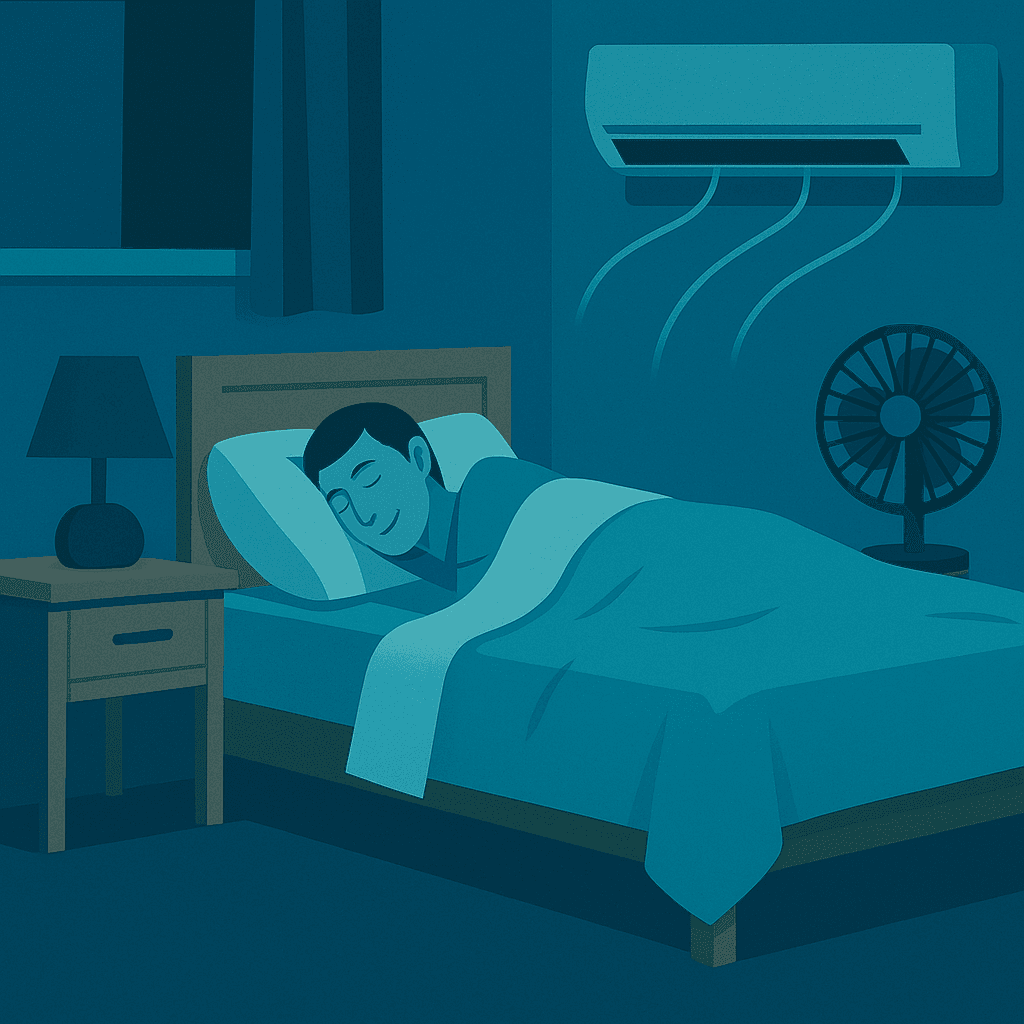Caffeine & Sleep: How Late Is Too Late? (2025 Guide)
It’s three in the afternoon. The inbox is full, the brain fog is real, and someone in your office cracks open a can of Celsius. Hours later, they’ve forgotten about it — until they’re staring at the ceiling at midnight. That can, it turns out, hasn’t forgotten them.

Set your caffeine cutoff early: timing matters as much as dose.
What Exactly Is Caffeine?
Caffeine is a plant alkaloid, originally evolved as a natural pesticide. Humans found another use: it became the world’s most widely consumed psychoactive substance. Coffee beans, tea leaves, cacao pods, and guarana berries all contain it; by the 1800s, chemists had isolated it, and by the 2000s, it was fueling everything from $6 lattes to neon-colored energy drinks.
Its power lies not in “giving energy,” but in masking fatigue. Your brain produces a molecule called adenosine throughout the day. The more adenosine builds up, the sleepier you feel. Caffeine blocks adenosine receptors, like a counterfeit key fitting the lock. The fatigue is still there, silently stacking in the background, but your brain can’t hear it. When the caffeine finally wears off, the crash comes.
How Long Does It Linger?
The half-life of caffeine averages about five hours. That means if you drink 200 mg at 3:00 p.m., you’ll still have ~100 mg in your system by 8:00 p.m. For some people, caffeine clears much faster; for others, it takes nine or more hours.
Everyday translations:
- A Celsius Original (200 mg) at 3:00 p.m. = like having a Red Bull still in your body at bedtime.
- A Starbucks Grande Pike (310 mg) at noon = like carrying the caffeine equivalent of a soda (75 mg) into bed.
Some people laugh about drinking espresso after dinner and “sleeping fine.” But EEG studies tell another story: their sleep is shallower, with less slow-wave and REM, even if they don’t notice.
How Much Caffeine Is in Popular Drinks?
Studies talk in milligrams. Consumers live in brands. Here’s how they line up:
- Brewed Coffee (8 oz): ~95 mg
- Starbucks Grande Pike (16 oz): ~310 mg
- Red Bull (8.4 oz): ~80 mg
- Celsius Original (12 oz): ~200 mg
- Celsius Heat (16 oz): ~300 mg
- Black Tea (8 oz): ~40–70 mg
- Coca-Cola (12 oz): ~35 mg
👉 Perspective:
- Two Celsius = 400 mg, the FDA’s daily upper safe limit.
- A Grande Pike (310 mg) + a Red Bull (80 mg) = ~390 mg.
- One “casual” large coffee may equal several energy drinks.
What the Science Says: Caffeine’s Measured Assault on Sleep
To understand how caffeine affects sleep, you need to look at well-controlled experiments, meta-analyses, and the way dose and timing interact. Together, they tell a clear story: caffeine trims minutes from your night, often without you realizing it.
Meta-Level Findings
- A 2023 systematic review of 24 trials (>1,700 people) found caffeine consistently:
- Reduced total sleep time by ~45 minutes
- Lowered sleep efficiency by ~7%
- Delayed sleep onset by ~9 minutes
- Increased WASO (wake after sleep onset), meaning more nighttime awakenings
- Earlier reviews agree: caffeine reliably prolongs the time it takes to fall asleep, shortens sleep length, and lowers perceived sleep quality.
These averages anchor the science: caffeine, even in modest doses, makes sleep lighter and shorter.
Key Dose × Timing Experiments
Here’s where the numbers become real. Controlled sleep-lab studies show not just that caffeine harms sleep, but how much depending on when and how you consume it.
| Study | Dose & Source (approximate drinks) | Timing | Key Outcome(s) |
|---|---|---|---|
| Drake et al., 2013 (Journal of Clinical Sleep Medicine) | 400 mg ≈ 2 grande coffees (Starbucks) or 2 Celsius cans | 0, 3, or 6 hours before bed | Even at 6 hours pre-bed, participants lost >60 minutes of sleep and had more awakenings. |
| Rogers et al., 2024 (Oxford / Sleep) | 100 mg ≈ 1 small coffee vs. 400 mg ≈ 2 grande coffees | Morning / Afternoon / Evening | 400 mg within 12 hours of bedtime impaired sleep. 100 mg up to 4h before bed had milder effects for many. |
| Doherty et al., 2025 (Athlete Meta-Analysis) | 3–6 mg/kg ≈ 1–2 large coffees | Late afternoon / evening | Sleep efficiency dropped by ~5%, even when total time wasn’t drastically reduced. |
| Weibel et al., 2021 (Nature Scientific Reports) | Habitual morning/afternoon coffee drinkers (200–400 mg daily) | No late caffeine | No major changes in sleep architecture, suggesting timing is the critical factor. |
Translation Into Everyday Terms
Imagine you drink 400 mg of caffeine — about two grande Starbucks coffees, or two cans of Celsius — at 4:00 p.m. You’d expect to be fine by bedtime. But studies show you’ll still lose an hour of total sleep, with more wake-ups and lighter cycles.
Meanwhile, a single small coffee (100 mg) four hours before bed may seem harmless. For some people, it is — but for others, especially slow metabolizers, even that dose pushes sleep onset later and trims deep sleep.
The most striking finding? Many participants in these studies swore they “slept fine.” Only brain-wave recordings revealed the hidden truth: their brains spent less time in slow-wave (deep) and REM stages, and more in shallow, unrestorative sleep.

Sleep loss increases with later timing and higher doses of caffeine.
When to Cut Yourself Off
There’s no single answer, but the science points to clear guardrails:
- 8 hours before bed: safest cutoff (10:30 p.m. bedtime → last caffeine around 2:30 p.m.).
- 6 hours before bed: tolerable for some, but keep total intake ≤200 mg.
- Within 4 hours of bed: disruptive for most people, even at smaller doses.
- ≥400 mg within 12 hours of bed: reliably damaging to sleep architecture.
The Bigger Picture
Caffeine sharpens the senses and smooths out the morning fog. But it isn’t free. It’s a loan against the night, paid back in minutes of lost deep sleep and groggy awakenings.
The best strategy isn’t abstinence — it’s timing and moderation:
- Front-load caffeine early in the day.
- Keep daily intake around 200–300 mg.
- Treat caffeine like sunlight: useful in the morning, disruptive at night.
Key Takeaway
A Red Bull at dinner isn’t just a small boost — it’s like falling asleep with a cup of black tea still buzzing in your system. A Celsius at 5:00 p.m. means you’re carrying half a Red Bull into bed at midnight.
If better sleep is the goal, the rule is simple: enjoy caffeine early, cut it off by mid-afternoon, and let the night do its work.
References
- FDA – Spilling the Beans on Caffeine
- Mayo Clinic – Caffeine Content of Drinks
- NIH – Caffeine Overview (NCBI Bookshelf)
- Drake, C. et al. (2013). Caffeine effects on sleep taken 0, 3, or 6 hours before bedtime. Journal of Clinical Sleep Medicine. Link
- Rogers, P. et al. (2024). Dose and timing effects of caffeine on sleep. Sleep (Oxford University Press).
- Watson, E. et al. (2023). The effect of caffeine on subsequent sleep: A systematic review. PubMed ID: 36870101.
- Doherty, C. et al. (2025). Evening caffeine ingestion and sleep in athletes: A meta-analysis. MDPI.
- Weibel, J. et al. (2021). Regular caffeine intake delays REM sleep promotion and sleep EEG markers of sleep homeostasis. Nature Scientific Reports.
RELATED TOPICS
POPULAR IN BETTER SLEEP SOLUTIONS

Alcohol & Sleep: Why Nightcaps Backfire (2025 Guide)
Alcohol can help you fall asleep faster—but it suppresses REM, fragments the night, and leaves you groggy. Practical cutoffs and standard drink math.

Sleep Disorders and Challenges
Understand insomnia, sleep apnea, restless legs, nightmares, and jet lag, plus practical next steps.

Why You Get Hot When You Sleep (and What to Do About It)
Why nights feel hot: your circadian rhythm, REM sleep quirks, and the bed microclimate. Fixes for cooler, deeper sleep.
RELATED TOPICS
POPULAR IN BETTER SLEEP SOLUTIONS

Alcohol & Sleep: Why Nightcaps Backfire (2025 Guide)
Alcohol can help you fall asleep faster—but it suppresses REM, fragments the night, and leaves you groggy. Practical cutoffs and standard drink math.

Sleep Disorders and Challenges
Understand insomnia, sleep apnea, restless legs, nightmares, and jet lag, plus practical next steps.

Why You Get Hot When You Sleep (and What to Do About It)
Why nights feel hot: your circadian rhythm, REM sleep quirks, and the bed microclimate. Fixes for cooler, deeper sleep.